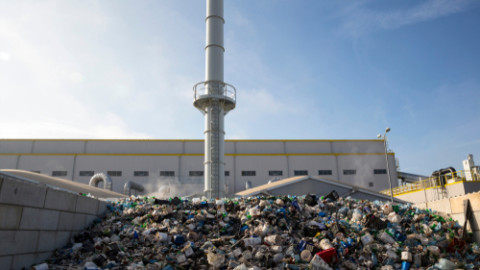As COVID-19-related border closures have curtailed commercial aviation activity globally, the sector continues to deal with another, longer-term challenge – the need to flatten its steep CO2-emissions trajectory in the face of stricter decarbonisation targets.
By 2050, demand for air travel is predicted to rise to over eight billion passengers per year (based on pre-COVID trends), meaning commercial aviation’s carbon footprint could triple in size by mid-century.
Acknowledging the need for action, in 2009, the sector’s peak body, the International Air Transport Association (IATA), set a target of reducing sector emissions to 50 per cent of 2005 levels by 2050 – equivalent to a 90 per cent reduction per passenger-mile.
The sector has responded by achieving fuel-efficiency improvements of around two per cent annually, but a deeper transformation will be needed to meet IATA’s 2050 decarbonisation target and enable the sector to operate sustainably into the future.
A key to that transformation, according to a recent joint CSIRO/Boeing report, is clean hydrogen, generated from the electrolysis of water, via renewable energy sources like solar and wind.
Step-by-step transition
The CSIRO/Boeing report, Opportunities for hydrogen in commercial aviation, sets out a series of steps that the aviation sector can take over the next 30 years to shift its dependence from carbon-emitting fuels and power sources to low- or zero-emissions hydrogen.
The analysis covers airports and ancillary transport and services, as well as aircraft. The steps are based on expected timeframes for development and take-up of the hydrogen technologies involved, ranging from the short-term (the next five to ten years), to medium-term (to 2035), to long-term (2050 and beyond).
Lead author, Sam Bruce – Manager, Global, CSIRO Futures – said that by identifying energy-transition opportunities now, the report gives industry, research agencies and governments time to assess and prioritise investment opportunities, and put in place the right incentives, regulations, policies and standards.
The first step begins with progressively replacing diesel- and petrol-powered ground support vehicles and equipment (or GSE) that service airport operations with electric/fuel-cell equivalents.
The second step is based on the gradual substitution of kerosene-based aviation fuels – a high-use operating material in commercial aircraft – with a fuel-blend based on drop-in ‘electrofuels’ derived from clean hydrogen and waste CO2.
The third and final step of the plan – developing 100 per cent hydrogen-powered, long-distance jet aircraft – is still somewhat conceptual, according to Mr Bruce and his co-author, Dr Chris Munnings, a senior researcher with CSIRO Energy Technology.
How that final phase plays out will depend on what happens with environmental regulations and hydrogen technology in the meantime.
Airports as clean energy hubs
The first stage of the plan – a shift from diesel/petrol GSE to hydrogen-fuel-cell powered GSE – could realistically start tomorrow, said Mr Bruce.
Large airports could start retrofitting and replacing existing forklifts, buses, cars and back-up generators with off-the-shelf hydrogen-fuel-cell equivalents.
“The GSE is the mature technology, the low hanging fruit,” said Mr Bruce. “This first stage is more about economics and providing the right incentives for airports to change over their GSE fleets and overcome that initial capital cost barrier to hydrogen technology – even though long term we expect hydrogen and fuel-cell solutions to become more economical.”
At the same time, investment incentives could propel the continued development of fuel-cell versions of special -purpose GSE, such as baggage loaders and pushback tugs, which will become more affordable as demand increases.
“That first stage is about taking mature technology from the automotive sector, and using it or in some cases modifying it, to get that foot in the door for hydrogen into the airport,” said Dr Munnings.
“When the drive trains of GSE vehicles go from diesel engines to fuel cells, it will improve their efficiency. Even though hydrogen fuel is slightly more expensive, in many cases the cost of running fuel-cell vehicles will go down, because they’re a lot more efficient.
“So that starts to build scale in the hydrogen supply chain. It also starts to get all of the standards and regulations around getting hydrogen onto an airport resolved – the legislative challenges, the safety challenges – they’re all worked out when you start switching the bus that takes passengers to the aircraft to fuel-cell.”
The report also highlights the opportunity for airports to become clean hydrogen transport hubs, with on-site electrolysers– powered by solar or wind – generating hydrogen from water to supply public refuelling stations.
These on- or near-airport refuelling stations could service buses, fleet vehicles and – down the track – trains, increasing the demand for on-site hydrogen production at airports.
Airports in several countries – including Japan, the US, the UK, Norway, Korea and Germany – have already introduced or are introducing public refuelling stations.
Longer term – the electrofuels era
As airport and logistics operators deploy more fuel-cell equipment and develop on-site electrolyser facilities on the ground, airlines can begin a transition to more sustainable aviation fuels (SAFs) for long-haul aircraft.
To date, commercial aviation’s take-up of the most well-known SAF, biofuel, has been slow. Other electrofuels, however, have the potential to be a game-changer, according to the report.
Electrofuels are made by reacting clean hydrogen with waste CO2 captured from biogas or wastewater treatment.
CO2 from fossil fuel combustion, however, brings its own carbon footprint. An emerging technology that has triggered strong interest globally is direct air capture of CO2 via large fans and special filters – a technology that could dramatically boost the prospect of cheaper electrofuels production.
The resulting synthetic fuel can be blended with conventional fuel and simply ‘dropped in’ to existing aircraft, with no need for modifications.
Mr Bruce notes that while the cost of the electrofuels is high at the moment, the production processes are underpinned by a strong technological and regulatory base that can be used to ramp up future production and use.
“The electrofuels value chain and processes are all underpinned by mature technology,” he said. “The three components – hydrogen production, CO2 capture and fuel synthesis – have already been de-risked.
“However, to date, there’s been no large-scale, end-to-end commercial demonstration – from hydrogen production and CO2 capture, through to electrofuels.”
Fuel-blending quotas
The report suggests that the most efficient way to introduce electrofuels to the aviation sector is to introduce blending quotas that increase over time – from a mix of 50 per cent electrofuels and conventional fuel, to 75 per cent electrofuels, to 100 per cent.
Over time, the bigger production plant capacity established to meet the demand generated by higher blending quotas will help reduce the cost of electrofuels.
“By 2040, with the investment priorities set out in the report, electrofuels might be only 1.5 to 2.5 times the cost of conventional jet fuel,” said Mr Bruce.
“Because there’s such a significant lead time, industry and government will likely need to find ways to limit the cost pass through, because jet fuel is such a material operating cost.”
Mr Bruce said Australia, with its renewable energy resources and proven technical expertise, is well-positioned to become a key exporter of hydrogen and electrofuels, shipping to countries like Japan, Korea and Germany, which are all turning to clean hydrogen to reduce their CO2 emissions.
“So Australia would want to be producing electrofuels as well as clean hydrogen, because hydrogen on its own has a low volumetric density and it’s much easier to transport in the form of a synthetic fuel.
“At the moment, Germany has the key technical expertise, and is leading the way in developing larger electrolysers and in producing electrofuels.
“Australia has abundant and cheap renewable resources and technical expertise as well. In fact, the key focus of the recent agreement between Australia and Germany is building global supply chains for hydrogen.”
Whole-of-sector approach
Mr Bruce is cautiously confident that the gradual phase-in of electrofuels, as set out in the report, will help commercial aviation meet IATA’s 2050 emissions reduction target.
But such a transition would also require all players involved with the sector to commit to such a plan. “This report shows a way for the aviation sector to decarbonise.
It shows that we can start today, the technologies are here, and here are the steps you need to take. “Even though there’s a strong technical and regulatory base to build upon, the shift to hydrogen is going to require a significant, global, cross-sector effort, in terms of going from commercial demonstrations to producing the significant volumes you need to build an electrofuels industry.
“It is scale that’s needed to decrease the cost of clean hydrogen. There’s still significant R&D required as well to improve costs, but the volumes are significant.”


















